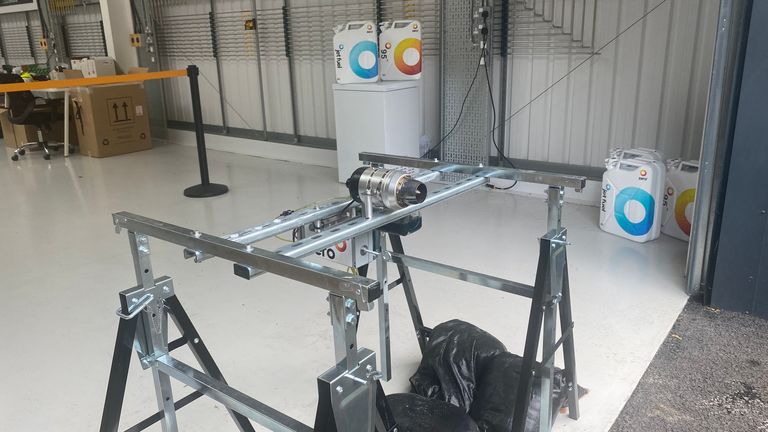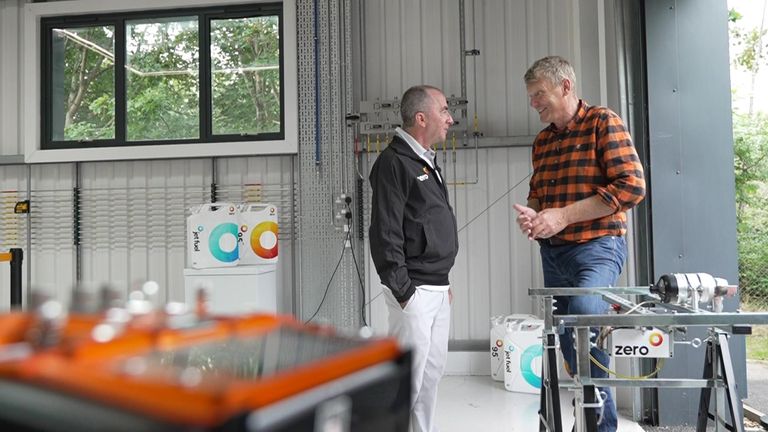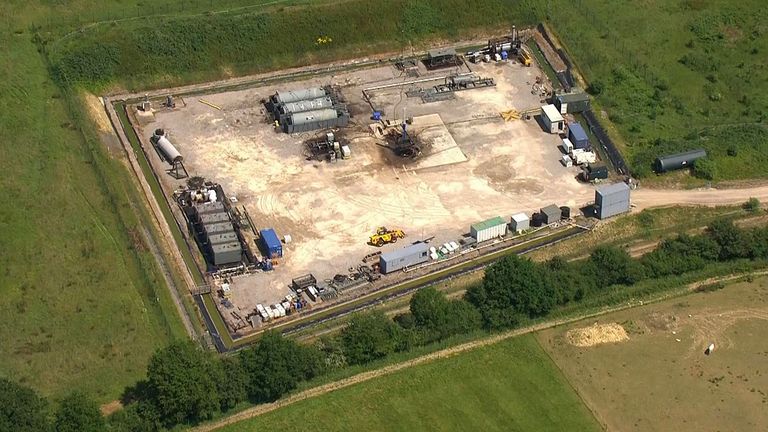I’m looking at a jet engine. The thrust builds and it strains to move. The heat plume shimmers the air behind it. As the whining roar builds, ear plugs are needed.
I’m only three metres away and the engine, the size of a rugby ball, is attached to a well-secured bench, but what makes it unique is the fuel: almost zero carbon, no oil or gas involved, made from air and water.
A glimpse of a possible future powered by synthetic fuel.
Its creator Paddy Lowe looks on admiringly.
“There are no fossil molecules in there. Because all the molecules that are in that hydrocarbon come from hydrogen, from water and from carbon dioxide from the air.
“The problem with global warming is fossil carbon dug out of rocks and released into the atmosphere is imbalanced. This is now balanced.”
Paddy has an impressive engineering pedigree with top technical roles at three Formula One teams contributing to 12 championship titles.
But now he heads Zero Petroleum, a company making liquid fuels with the ability to power conventional engines with minimal climate impact.
They use what’s called direct air capture technology to pull carbon dioxide from the air and electrolysis to obtain hydrogen from water.
These are then combined to make a hydrocarbon liquid fuel: known as synthetic or E-fuel.
‘Guilt-free combustion’
The whole process demands large amounts of energy. But Paddy claims it yields guilt-free combustion.
“Everywhere we use fossil fuels today is a great candidate for synthetic fuels.
“We see a day, in a few decades, where all of the fuel we use today, that comes out of the ground from oil wells, will be delivered as synthetic and made industrially from air and water.”
He believes this will create an industry of similar size to the oil and gas business today.
They’ve already worked with the RAF to fuel a plane with their fuel.
The team also claims another advantage for synthetic fuels: they are made from scratch and so can be more precisely engineered to enhance the performance of different engines and with fewer pollutants.
But, for now, their factory is more like a lab, very hi-tech and with a palpable buzz of engineering creativity but small: only capable of producing 30 litres of synthetic fuel a day and at an eye-watering cost.
Zero Petroleum has 44 members of staff – some from F1 and others from the oil and gas sector – wanting to use their skills to make a difference to the world.
Read more:
Daffodil extract fed to cows could be ‘game changer’ in reducing methane production
Revealed: Which brands are responsible for most litter pollution in the UK
‘Saving the world in my own way’
One of them is research chemist Vida Arthur who said: “Our process takes carbon dioxide out of the environment and then we are using it to make something beneficial to society… I’m not damaging the environment but saving the world in my own way.”
Paddy and his team expect the early users to be aircraft but believe synthetic fuels will be used in road cars and lorries alongside batteries.
But many energy experts have doubts over their widespread adoption given the huge electricity and technology demands of the whole synthetic fuel production cycle.
E-fuel production ‘costs a lot of money’
Colin Walker from the Energy and Climate Intelligence Unit says the physics of synthetic fuel means the economics are stacked against it.
“You need five times as much electricity to produce fuels than you do just simply putting electricity into the battery of an electric vehicle and letting it go in its way.
“And that means five times as many wind turbines, solar panels, and that costs a lot of money.
“I do see E-fuels playing a role to power much harder to decarbonise sectors like aviation, but I think we have an excellent technology in battery electric vehicles. It’s already being rolled out.”
Liquid fuels are potent, transportable and compatible with so much current infrastructure that it’s easy to see the appeal of a climate-friendly version.
But many observers suspect that their development may prolong our damaging addiction to burning stuff.






